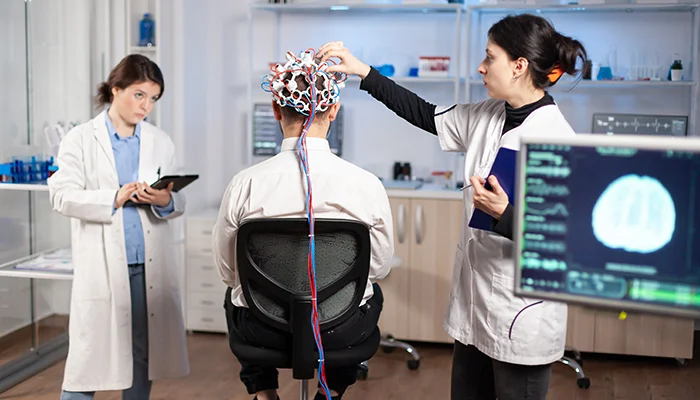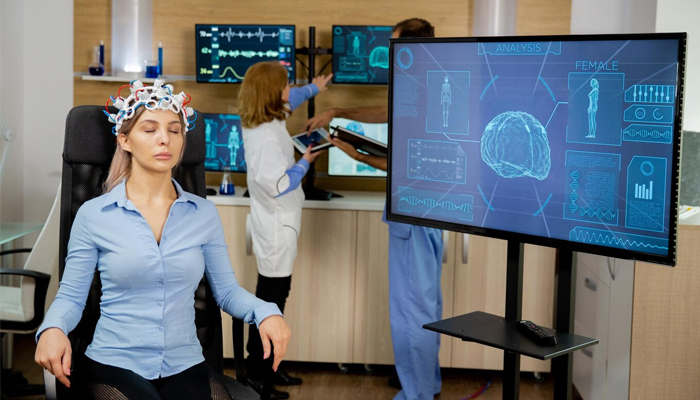AI in Early Disease Detection: Process, Use Cases, and More

MAR, 21, 2024 12:25 PM
AI in Early Disease Detection: Process, Use Cases, and More
Artificial intelligence (AI) has revolutionised numerous industries, and healthcare is no exception. One of the most impactful applications of AI in healthcare is early disease detection. By leveraging AI algorithms, machine learning models, and data analytics, healthcare providers can detect diseases at early stages, leading to timely interventions, improved patient outcomes, and reduced healthcare costs.
In this comprehensive guide, we'll explore the process of AI in early disease detection, examine various use cases across different medical domains, discuss challenges and opportunities, and showcase the transformative potential of AI in revolutionising healthcare delivery.
Understanding AI in Early Disease Detection:
AI in early disease detection involves the use of advanced computational techniques to analyse medical data, identify patterns, detect anomalies, and predict disease risks. The process typically includes the following steps:
Data Collection:The first step in AI-driven disease detection is collecting diverse and comprehensive medical data, including electronic health records (EHRs), medical imaging data (e.g., X-rays, MRIs, CT scans), genetic information, patient demographics, lifestyle factors, and historical health records. Data sources may also include wearable devices, health monitoring sensors, and patient-reported outcomes.
Data Preprocessing:Once the data is collected, it undergoes preprocessing steps to clean, normalise, and standardise the data for analysis. This includes handling missing values, encoding categorical variables, scaling numerical features, and performing data transformations as needed. Data preprocessing is crucial for ensuring data quality, accuracy, and compatibility with AI algorithms.
Feature Extraction and Selection:Feature extraction involves identifying relevant features or variables from the dataset that are predictive of disease outcomes or risk factors. Feature selection techniques, such as statistical methods, dimensionality reduction algorithms (e.g., PCA), and feature importance analysis, help identify the most informative features for training AI models.
Model Training:AI models, such as machine learning classifiers (e.g., logistic regression, decision trees, support vector machines) or deep learning models (e.g., neural networks, convolutional neural networks), are trained using labelled data to learn patterns, relationships, and predictive associations between input features and disease outcomes. Training involves optimising model parameters, evaluating model performance, and fine-tuning model architectures for optimal accuracy and generalisation.
Model Evaluation and Validation:Trained AI models are evaluated and validated using independent test datasets or cross-validation techniques to assess their performance, reliability, and generalizability. Performance metrics such as accuracy, sensitivity, specificity, precision, recall, and F1 score are used to evaluate model efficacy in disease detection and risk prediction.
Deployment and Integration:Once validated, AI models are deployed into clinical workflows, healthcare systems, or diagnostic tools to assist healthcare providers in early disease detection. Integration with electronic medical records (EMRs), diagnostic imaging systems, telehealth platforms, and mobile applications enables seamless data exchange, real-time decision support, and personalised patient care.
Use Cases of AI in Early Disease Detection:
AI-powered early disease detection has demonstrated remarkable potential across various medical domains and conditions. Some notable use cases include:
Cancer Detection:AI algorithms analyse medical imaging data, such as mammograms, CT scans, and MRI images, to detect early signs of cancer, including breast cancer, lung cancer, prostate cancer, and skin cancer. Deep learning models can identify abnormal tissue growth, tumours, and suspicious lesions with high accuracy, enabling early diagnosis and treatment planning.
Cardiovascular Risk Assessment:AI models leverage patient data, including medical history, vital signs, blood tests, and electrocardiograms (ECGs), to assess cardiovascular risk factors, such as hypertension, high cholesterol, diabetes, and heart disease. Predictive analytics and risk scoring algorithms help identify individuals at high risk of cardiovascular events and guide preventive interventions.
Diabetes Management:AI-driven tools monitor glucose levels, insulin sensitivity, dietary patterns, physical activity, and medication adherence to optimise diabetes management and prevent complications. Predictive algorithms can predict hypoglycemic or hyperglycemic events, recommend personalised treatment plans, and provide real-time feedback to patients and healthcare providers.
Neurological Disorders:AI algorithms analyse brain imaging data, such as MRI scans and EEGs, to detect early signs of neurological disorders, including Alzheimer's disease, Parkinson's disease, epilepsy, and stroke. Pattern recognition techniques and biomarker analysis aid in early diagnosis, disease progression monitoring, and treatment optimisation.
Challenges and Opportunities in AI-Driven Disease Detection:

While AI holds tremendous promise for early disease detection, several challenges and opportunities must be addressed:
Data Quality and Bias:Ensuring data quality, accuracy, and representativeness is crucial for AI models to deliver reliable and unbiased results. Addressing data biases, data imbalances, and data interoperability issues requires robust data governance frameworks, data standardisation protocols, and data quality assurance measures.
Interpretability and Explainability:AI models often operate as "black boxes," making it challenging to interpret model decisions and explain predictions to clinicians and patients. Enhancing model interpretability, transparency, and explainability through model visualisation techniques, feature importance analysis, and decision support tools is essential for fostering trust and adoption.
Regulatory Compliance:Adhering to regulatory standards, ethical guidelines, and data privacy regulations, such as HIPAA, GDPR, and FDA regulations, is critical for AI-driven healthcare applications. Compliance frameworks, ethical AI principles, and governance mechanisms ensure responsible use of AI technologies and the protection of patient rights and confidentiality.
Integration and Adoption:Integrating AI solutions into clinical workflows, healthcare systems, and medical devices requires collaboration between AI developers, healthcare providers, regulatory agencies, and industry stakeholders. User training, education, and change management strategies facilitate the adoption, acceptance, and utilisation of AI tools by healthcare professionals and patients.
Scalability and Sustainability:Scaling AI-driven disease detection initiatives requires scalable infrastructure, computational resources, and data storage capabilities. Cloud computing, distributed computing frameworks, and data analytics platforms support scalability, performance optimisation, and resource efficiency for large-scale AI deployments in healthcare settings.
The Future of AI in Early Disease Detection:
The future of AI in early disease detection is characterised by ongoing advancements in AI technologies, data analytics, digital health platforms, and precision medicine approaches. Key trends and developments shaping the future of AI-driven disease detection include:
AI-Powered Precision Medicine:AI algorithms enable personalised risk assessment, treatment selection, and therapeutic interventions tailored to individual patient profiles, genetic factors, biomarkers, and lifestyle factors. Precision medicine approaches optimise patient outcomes, minimise treatment side effects, and improve healthcare delivery efficiency.
Multimodal Data Fusion:Integrating diverse data sources, such as genomics, proteomics, metabolomics, imaging data, clinical notes, and patient-reported outcomes, enables comprehensive disease characterization, early detection of complex diseases, and targeted interventions. Multimodal data fusion techniques leverage AI-driven data integration and analysis for holistic patient care.
Real-Time Health Monitoring:AI-powered wearable devices, biosensors, and IoT (Internet of Things) devices enable real-time health monitoring, continuous vital sign tracking, and early detection of health anomalies. Remote patient monitoring solutions facilitate proactive interventions, remote consultations, and telehealth services, enhancing patient engagement and care coordination.
Explainable AI and AI Ethics:Advancements in explainable AI, interpretable machine learning models, and AI ethics frameworks promote transparency, accountability, and ethical use of AI in healthcare. Explainable AI techniques enable clinicians to understand model decisions, validate model outputs, and make informed clinical decisions based on AI-driven insights.
Collaborative AI Ecosystems:Collaborative AI ecosystems bring together interdisciplinary teams, healthcare providers, academic institutions, technology partners, and industry stakeholders to collaborate on AI-driven research, innovation, and knowledge sharing. Open-source AI frameworks, data sharing initiatives, and collaborative platforms accelerate AI adoption, research reproducibility, and innovation in healthcare.
Here are some additional insights and developments in the realm of AI in early disease detection:
AI-Driven Drug Discovery:AI technologies, such as deep learning algorithms and virtual screening platforms, are revolutionising drug discovery and development processes. AI models analyse vast datasets of chemical compounds, genomic data, and biological interactions to identify potential drug candidates, predict drug efficacy, and optimise drug design. AI-driven drug discovery accelerates the discovery of novel therapies for various diseases, including cancer, infectious diseases, neurological disorders, and rare diseases.
Genomic Medicine and AI:The integration of AI with genomic medicine is transforming the landscape of personalised healthcare. AI algorithms analyse genomic sequencing data, identify genetic variants, interpret genetic mutations, and predict disease susceptibility. AI-powered genomic analysis enables precision medicine approaches, genetic counselling, pharmacogenomics, and targeted therapies tailored to individual genetic profiles.
AI-Based Medical Imaging Analysis:AI-based medical imaging analysis is enhancing diagnostic accuracy, reducing interpretation errors, and improving patient outcomes across radiology, pathology, and imaging specialties. AI algorithms analyse medical images, such as X-rays, CT scans, MRI scans, and histopathology slides, to detect abnormalities, classify lesions, quantify disease severity, and assist radiologists and pathologists in clinical decision-making. AI-driven imaging technologies improve early detection of tumours, vascular diseases, musculoskeletal disorders, and other medical conditions.
Remote Monitoring and AI-Powered Wearables:AI-powered wearable devices, IoT sensors, and remote monitoring solutions enable continuous health monitoring, real-time data collection, and early detection of health risks. Wearable AI technologies track vital signs, physiological parameters, activity levels, sleep patterns, and medication adherence, providing actionable insights for preventive care, chronic disease management, and remote patient monitoring. AI-driven wearables facilitate early intervention, telemedicine consultations, and personalised wellness recommendations for individuals of all ages and health conditions.
Ethical Considerations and AI Governance:As AI becomes increasingly integrated into healthcare systems and clinical practice, addressing ethical considerations, AI governance frameworks, and regulatory standards is paramount. Ethical AI principles, fairness assessments, transparency guidelines, and bias mitigation strategies ensure responsible AI deployment, ethical decision-making, and equitable healthcare access. Collaborative efforts between AI developers, healthcare regulators, ethicists, and patient advocacy groups promote AI ethics awareness, public trust, and regulatory compliance in AI-driven healthcare applications.
AI-Enabled Clinical Decision Support:AI-driven clinical decision support systems (CDSS) provide real-time insights, evidence-based recommendations, and predictive analytics to support healthcare providers in diagnostic decision-making, treatment planning, and patient management. CDSS leverages AI algorithms, medical knowledge databases, clinical guidelines, and patient data to assist clinicians in interpreting complex medical information, identifying treatment options, and optimising care pathways. AI-enabled CDSS improves clinical workflow efficiency, reduces diagnostic errors, and enhances patient safety in healthcare settings.
Patient Empowerment and AI-Driven Health Education:AI-powered health education platforms, chatbots, and virtual assistants empower patients with personalised health information, self-management tools, and educational resources. AI-driven health chatbots provide interactive communication, symptom triage, medication reminders, and lifestyle coaching to enhance patient engagement, health literacy, and adherence to treatment plans. AI-driven health education initiatives promote preventive care, disease awareness, and patient empowerment in managing chronic conditions, mental health, and overall well-being.
In conclusion, the intersection of AI and early disease detection is driving transformative innovations, improving healthcare outcomes, and empowering individuals to lead healthier lives. As AI technologies continue to evolve, collaborate, and integrate with healthcare systems, the future holds immense potential for AI to revolutionise disease prevention, personalised medicine, patient-centred care, and public health initiatives on a global scale. Embracing ethical AI practices, fostering interdisciplinary collaboration, and prioritising patient-centric approaches are key to harnessing the full potential of AI in early disease detection and healthcare innovation.




Strategy
Design
Blockchain Solution
Development
Launching
Testing
Maintenance
Contact US!
India

Plot 378-379, Udyog Vihar Phase 4 Rd, near nokia building, Electronic City, Phase IV, Sector 19, Gurugram, Haryana 122015
Copyright © 2025 PerfectionGeeks Technologies | All Rights Reserved | Policy
Strategy
Design
Blockchain Solution
Development
Contact US!
India 
Plot 378-379, Udyog Vihar Phase 4 Rd, near nokia building, Electronic City, Phase IV, Sector 19, Gurugram, Haryana 122015
USA 
1968 S. Coast Hwy, Laguna Beach, CA 92651, United States
Copyright © 2025 PerfectionGeeks Technologies | All Rights Reserved | Policy
